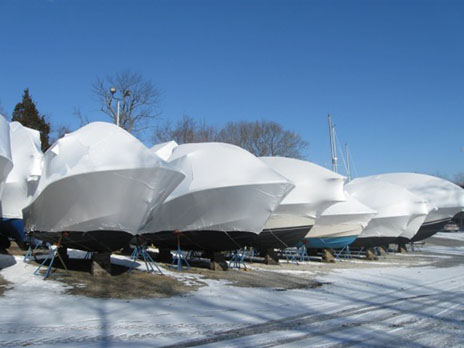Somewhere around the winter boat shows, for years our family calendar has a day marked off that we affectionately have referred to as “hug your boat weekend”. It’s late January, or early February each year, and of course weather dependent, but it’s a time that we literally schedule in to go up and check on the boat. Whether it is the cottage boat or boat in a marina, it’s a good idea to do this and potentially head off any issues that may haunt you come spring. It’s a day of winter fun (we often coordinated it with our marina’s “Winter Festivities Day”), a nice warm lunch out at a favourite restaurant (or a meal of hot soup in a thermos and cheese and crackers on board under the shrinkwrap), and a chance to start dreaming again about the upcoming season. Yes, it’s also perhaps a day of work perhaps depending on what’s happened with the boat cover. Does it need shoveling off? Do some of the lines need retying? Do the trailer supports need to be adjusted?
Plan ahead, take a broom, a shovel, extra rope, perhaps a ladder, and some extra “tarp-cleats” that you place as needed anywhere on the cover. Don’t go visit your boat alone in case you fall or injure yourself (practice the buddy system) and remember to follow these winter boat-check safety tips courtesy of Boat US:
“Boating safety” usually means preventing injuries or accidents while on the water. Boats in winter storage have some unique safety concerns for boat owners who make periodic checkups over the long winter season. Here are five tips from the BoatUS Foundation for Boating Safety and Clean Water to help boaters stay safe while visiting their boat this winter.
1. Injuries from ladder falls can be severe but are preventable. When using a ladder to climb aboard your frozen boat, be sure it is firmly planted, secure it with a line to avoid shifting, and have someone hold the base. Never descend a ladder facing forward or with your arms full. If moving tools, supplies or other objects to and from the deck, lower or raise them in a bucket using a rope.
2. Don’t trust the nonskid to do its job. Nonskid decks are slippery when covered by snow or encrusted with ice. Brush away any buildup on the deck where you plan to step, and always hold onto something, just as you would if you were underway. In warmer winter climates, decaying leaves and algae can also make decks slippery.
3. Snow and ice are heavy. One square foot of dense, wet snow can weigh more than 20 pounds, so use caution when going underneath a tarp or winter cover that’s loaded with snow. For even a small boat stored outside, over a ton of weight can be added after a storm, so brush off what you can before climbing aboard.
4. Check your jackstands for proper support. Jackstands or blocking can shift as the boat gets laden with snow and ice, or due to repeated freeze/thaw cycles. Never adjust jackstands yourself. Have marina personnel adjust and move supports.
5. Trailer boat frames should be supported at the rear cross beam. This prevents the tongue from lifting off the ground like a seesaw when climbing aboard from the stern.

